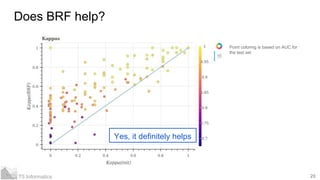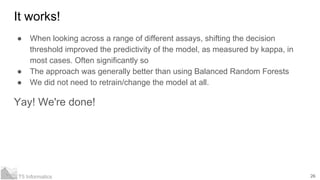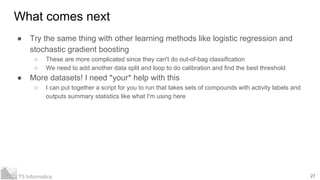Building useful models for imbalanced datasets (without resampling)
- 1. Building useful models for imbalanced datasets (without resampling) Greg Landrum Feb 2019 T5 Informatics GmbH [email protected] @dr_greg_landrum
- 2. 2T5 Informatics First things first ● RDKit blog post with initial work: http://rdkit.blogspot.com/2018/11/working-with-unbalanced-data-part-i.html ● The notebooks I used for this presentation are all in Github: ○ Original notebook: https://bit.ly/2UY2u2K ○ Using the balanced random forest: https://bit.ly/2tuafSc ○ Plotting: https://bit.ly/2GJSeHH ● I have a KNIME workflow that does the same thing. Let me know if you're interested ● Download links for the datasets are in the blog post
- 3. 3T5 Informatics The problem ● Typical datasets for bioactivity prediction tend to have way more inactives than actives ● This leads to a couple of pathologies: ○ Overall accuracy is really not a good metric for how useful a model is ○ Many learning algorithms produce way too many false negatives
- 4. 4T5 Informatics The accuracy problem Assay: CHEMBL1614421, PUBCHEM_BIOASSAY: qHTS for Inhibitors of Tau Fibril Formation Predicted inactive Predicted active Measured inactive 8681 4 Measured active 1102 22 Accuracy is high, but the model is pretty useless for predicting actives Overall accuracy: 88.7%
- 5. 5T5 Informatics The accuracy problem Assay: CHEMBL1614421, PUBCHEM_BIOASSAY: qHTS for Inhibitors of Tau Fibril Formation Predicted inactive Predicted active Measured inactive 8681 4 Measured active 1102 22 Overall accuracy: 88.7% kappa: 0.033 This one has an easy solution: use Cohen's kappa https://en.wikipedia.org/wiki/Cohen%27s_kappa https://link.springer.com/article/10.1007/s10822-014-9759-6 https://www.researchgate.net/publication/258240105_TheKappaStatistic_PaulCzodrowski kappa makes the problem obvious
- 6. 6T5 Informatics Is that model actually useless? Assay: CHEMBL1614421, PUBCHEM_BIOASSAY: qHTS for Inhibitors of Tau Fibril Formation Predicted inactive Predicted active Measured inactive 8681 4 Measured active 1102 22 Overall accuracy: 88.7% kappa: 0.033 AUC: 0.850 The ROC curve shows that the model has actually learned something about the bioactivity. Why aren't we seeing that in the predictions?
- 7. 7T5 Informatics Quick diversion on bag classifiers When making predictions, each tree in the classifier votes on the result. Majority wins In scikit-learn the predicted class probabilities are the means of the predicted probabilities from the individual trees We construct the ROC curve by sorting the predictions in decreasing order of predicted probability of being active. Note that actual predictions are irrelevant for a ROC curve. As long as true actives tend to have a higher predicted probability of being active than true inactives the AUC will be good.
- 8. 8T5 Informatics Ok, but who cares?
- 9. 9T5 Informatics An idea ● The standard decision rule for a random forest (or any bag classifier) is that the majority wins1 , i.e. at the predicted probability of being active must be >=0.5 in order for the model to predict "active" ● Shift that threshold to a lower value for models built on highly imbalanced datasets2 1 This is only strictly true for binary classifiers 2 F. Provost, T. Fawcett. "Robust classification for imprecise environments." Machine learning 42:203-31 (2001).
- 10. 10T5 Informatics How do we come up with a new decision threshold? 1. Generate a random forest for the dataset using a training set 2. Generate out-of-bag predicted probabilities using the training set 3. Try a number of different decision thresholds1 and pick the one that gives the best kappa Once we have the decision threshold, use it to generate predictions for the test set. 1 Here we use: [0.05, 0.1 , 0.15, 0.2 , 0.25, 0.3 , 0.35, 0.4 , 0.45, 0.5 ]
- 11. 11T5 Informatics Changing the decision threshold Assay: CHEMBL1614421, PUBCHEM_BIOASSAY: qHTS for Inhibitors of Tau Fibril Formation Threshold = 0.5 Predicted inactive Predicted active Measured inactive 8681 4 Measured active 1101 22 Overall accuracy: 88.7% kappa: 0.033 Threshold = 0.2 Predicted inactive Predicted active Measured inactive 8261 424 Measured active 595 528 Overall accuracy: 89.6% kappa: 0.451kappa has improved dramatically
- 12. 12T5 Informatics Why does it work? Prob(active) Superimpose Prob(active) on the ROC curve
- 13. 13T5 Informatics Why does it work? The predicted probabilities of being active are clearly carrying significant information about activity Prob(active) Superimpose Prob(active) on the ROC curve Plot TPR and FPR vs -Prob(active)
- 14. 14T5 Informatics It works! ● By shifting the decision threshold from 0.5->0.2 we managed to improve the predictivity of the model, as measured by kappa, from 0.033 to 0.451 ● We did not need to retrain/change the model at all. Yay! We're done!
- 15. 15T5 Informatics It works! ● By shifting the decision threshold from 0.5->0.2 we managed to improve the predictivity of the model, as measured by kappa, from 0.033 to 0.451 ● We did not need to retrain/change the model at all. Not quite done yet! ● This is just one model. Does this approach work broadly? ● Let's try a broad collection of datasets
- 16. 16T5 Informatics The datasets (all extracted from ChEMBL_24) ● "Serotonin": 6 datasets with >900 Ki values for human serotonin receptors ○ Active: pKi > 9.0, Inactive: pKi < 8.5 ○ If that doesn't yield at least 50 actives: Active: pKi > 8.0, Inactive: pKi < 7.5 ● "DS1": 80 "Dataset 1" sets.1 ○ Active: 100 diverse measured actives ("standard_value<10uM"); Inactive: 2000 random compounds from the same property space ● "PubChem": 8 HTS Validation assays with at least 3K "Potency" values ○ Active: "active" in dataset. Inactive: "inactive", "not active", or "inconclusive" in dataset ● "DrugMatrix": 44 DrugMatrix assays with at least 40 actives ○ Active: "active" in dataset. Inactive: "not active" in dataset 1 S. Riniker, N. Fechner, G. A. Landrum. "Heterogeneous classifier fusion for ligand-based virtual screening: or, how decision making by committee can be a good thing." Journal of chemical information and modeling 53:2829-36 (2013).
- 17. 17T5 Informatics Model building and validation ● Fingerprints: 2048 bit MorganFP radius=2 ● 80/20 training/test split ● Random forest parameters: ○ cls = RandomForestClassifier(n_estimators=500, max_depth=15, min_samples_leaf=2, n_jobs=4, oob_score=True) ● Try threshold values of [0.05, 0.1 , 0.15, 0.2 , 0.25, 0.3 , 0.35, 0.4 , 0.45, 0.5 ] with out-of-bag predictions and pick the best based on kappa ● Generate initial kappa value for the test data using threshold = 0.5 ● Generate "balanced" kappa value for the test data with the optimized threshold
- 18. 18T5 Informatics Does shifting the threshold actually help? Point coloring is based on AUC for the test set Yes, it definitely helps
- 19. 19T5 Informatics It works! ● When looking across a range of different assays, shifting the decision threshold improved the predictivity of the model, as measured by kappa, in most cases. Often significantly so ● We did not need to retrain/change the model at all. Yay! We're done!
- 20. 20T5 Informatics It works! ● When looking across a range of different assays, shifting the decision threshold improved the predictivity of the model, as measured by kappa, in most cases. Often significantly so ● We did not need to retrain/change the model at all. No, wait, there's still more... ● What about other approaches for handling imbalanced datasets?
- 21. 21T5 Informatics Quick diversion: How do bag classifiers end up with different models? Each tree is built with a different dataset
- 22. 22T5 Informatics Another approach: Balanced Random Forests1 ● Take advantage of the structure of the classifier. ● Learn each tree with a balanced dataset: ○ Select a bootstrap sample of the minority class (actives) ○ Randomly select, with replacement, the same number of points from the majority class (inactives) ● Prediction works the same as with a normal random forest ● Easy to do in scikit-learn using the imbalanced-learn contrib package: https://imbalanced-learn.readthedocs.io/en/stable/ensemble.html#forest-of-ra ndomized-trees ○ cls = BalancedRandomForestClassifier(n_estimators=500, max_depth=15, min_samples_leaf=2, n_jobs=4, oob_score=True) 1 C. Chen, A. Liaw, L. Breiman. “Using random forest to learn imbalanced data.” University of California, Berkeley (2004), https://statistics.berkeley.edu/sites/default/files/tech-reports/666.pdf
- 23. 23T5 Informatics Does BRF help? Point coloring is based on AUC for the test set Yes, it definitely helps
- 24. 24T5 Informatics How does BRF compare to shifting the threshold? Point coloring is based on AUC for the test set Shifting the threshold tends to do better
- 25. 25T5 Informatics Does shifting the threshold with BRF models help? Point coloring is based on AUC for the test set Nope, that doesn't do anything
- 26. 26T5 Informatics It works! ● When looking across a range of different assays, shifting the decision threshold improved the predictivity of the model, as measured by kappa, in most cases. Often significantly so ● The approach was generally better than using Balanced Random Forests ● We did not need to retrain/change the model at all. Yay! We're done!
- 27. 27T5 Informatics What comes next ● Try the same thing with other learning methods like logistic regression and stochastic gradient boosting ○ These are more complicated since they can't do out-of-bag classification ○ We need to add another data split and loop to do calibration and find the best threshold ● More datasets! I need *your* help with this ○ I can put together a script for you to run that takes sets of compounds with activity labels and outputs summary statistics like what I'm using here
- 28. 28T5 Informatics Prelim results: logistic regression
- 29. 29T5 Informatics Acknowledgements ● Dean Abbott (Abbott Analytics, @deanabb) ● Daria Goldmann (KNIME)
- 30. 30T5 Informatics More info ● RDKit blog post with initial work: http://rdkit.blogspot.com/2018/11/working-with-unbalanced-data-part-i.html ● The notebooks I used for this presentation are all in Github: ○ Original notebook: https://bit.ly/2UY2u2K ○ Using the balanced random forest: https://bit.ly/2tuafSc ○ Plotting: https://bit.ly/2GJSeHH ● I have a KNIME workflow that does the same thing. Let me know if you're interested ● Download links for the datasets are in the blog post






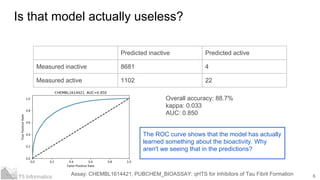


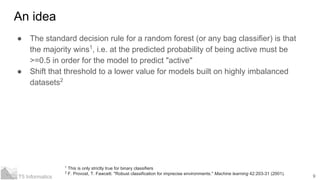
![10T5 Informatics
How do we come up with a new decision threshold?
1. Generate a random forest for the dataset using a training set
2. Generate out-of-bag predicted probabilities using the training set
3. Try a number of different decision thresholds1
and pick the one that gives the
best kappa
Once we have the decision threshold, use it to generate predictions for the test
set.
1
Here we use: [0.05, 0.1 , 0.15, 0.2 , 0.25, 0.3 , 0.35, 0.4 , 0.45, 0.5 ]](https://image.slidesharecdn.com/modelingimbalanceddatasets-distrib-190221133905/85/Building-useful-models-for-imbalanced-datasets-without-resampling-10-320.jpg)
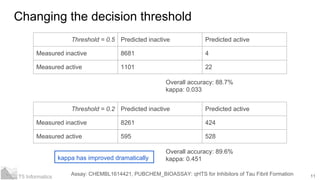





![17T5 Informatics
Model building and validation
● Fingerprints: 2048 bit MorganFP radius=2
● 80/20 training/test split
● Random forest parameters:
○ cls = RandomForestClassifier(n_estimators=500, max_depth=15, min_samples_leaf=2,
n_jobs=4, oob_score=True)
● Try threshold values of [0.05, 0.1 , 0.15, 0.2 , 0.25, 0.3 , 0.35, 0.4 , 0.45, 0.5 ]
with out-of-bag predictions and pick the best based on kappa
● Generate initial kappa value for the test data using threshold = 0.5
● Generate "balanced" kappa value for the test data with the optimized
threshold](https://image.slidesharecdn.com/modelingimbalanceddatasets-distrib-190221133905/85/Building-useful-models-for-imbalanced-datasets-without-resampling-17-320.jpg)





